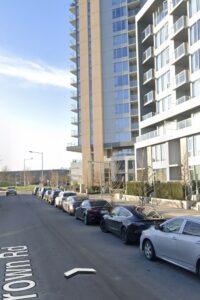Richmond, BC – Local Environmental History
November 23, 2022 By: Yang Ni
Location: 3333 Brown Road, 列治文不列颠哥伦比亚省加拿大

I live in Richmond, BC, just around Vancouver YVR airport. Richmond was incorporated as a municipality on November 10, 1879, and designated as a city on December 3, 1990. It is located at the meeting point of the Fraser River and the Pacific Ocean, which puts my city adjacent to some of the most productive ecosystems in the world. Fraser River is responsible for my city’s islands’ outlook and growth.
Citing the history of Lulu Island by Thomas Kidd, the outline of the islands evidence the formation of the Greek letter Delta. History has it that the matter carried down by rivers deposited at their outlets to have a letter-like form formed most parts of the Islands in Vancouver. According to Graeme Wood in the Richmond News blog, the Coast Salish people were the first human settlers in the area. The Coast Salish bands temporarily camped on the Island, where they fished and collected berries for food. This old fishing village is home to several museums, heritage sites, and a working harbour for fishing boats.
Richmond’s natural history blog points out that the Island has existed for approximately 11,000 years. Around 2 million years ago, the end of the ice age led to the retreat of the cordilleran ice sheets towards the mountains. They shed their met water and mineral-rich sediments into what is currently known as the Fraser valley. Fifteen thousand years ago, the ice also retreated into a geological location where Richmond City Hall sits presently. The sediments accumulated, leading to land rise, sand bars shift, and plant life flourishing. Floods changed the area’s channels, and plant debris accumulated, forming the first bogs. Mixing the saline ocean water and the Fraser Rivers Fresh water creates an estuary environment supporting a diverse community of aquatic and terrestrial life.
According to Richmond’s blog, the city has ecologically valuable areas and hosts many non-human species, some of which have existed for decades. Some ecologically valuable Bats, barn owls, coyotes, beavers, herons, eastern grey squirrels, northwestern crows, rabbits, snow geese, raccoons, and striped skunks have adapted to the area. Other migratory birds, such as cooper hawks, red-tailed hawks, falcons, harriers, and wading birds, such as the iconic great blue heron, and sandhill cranes, also exist. Also, the absence of natural predators such as wolves and cougars, eradicated from Richmond years ago, provides a suitable environment for these species survival. The positive environmental changes of human activities have made Richmond’s natural environment full of life. It has attracted some birds, such as the glaucous-winged gull. In the water are the salmons; the mighty white sturgeon have existed for decades. Richmond’s unique position also ensures a complex food chain, including harbour seals and California / Steller’s sea. Bogs, wetlands, sloughs, and grassland have made the city a terrestrial habitat with wild blueberries, lilies, cranberries, and carnivorous sundew covering the ground. Richmond’s plant diversity also includes a variety of plants, among them the smallest flowering plant in the world, known as the northern watermeal. Also, the forests are home to the world’s largest trees, including coastal Douglas-fir.
Currently, Vancouver is known for its living walls. Greenroofs blog notes that the Vancouver International Airport has adopted the living landscape master plan to maintain the ecological uniqueness of the environment. According to Randy, a key airport architect, the Grant McConachie Way corridor, which leads into the YVR, is designed to maintain a natural aesthetic that links Vancouver to B.C. and the world beyond. Randy drew upon the estuary theme of Sea Island to create a landscape that features a four-season effect that would evolve with time. The blog’s development and rezoning section notes that the area incorporates shrub planting and major native trees to enhance view corridors. Although not everyone would appreciate the environmental benefits of living in green walls, the aesthetics it produces is worth it. This is a good example of the people-plant interaction by Turner and Peacock. In addition, the green walls are meant to enhance Vancouver’s culture that speaks to even the visitor with a message that the cosmopolitan is progressive and cares about the environment and is open to new technologies and methods that would help it innovate. I have also learned that most of the native plants that cover most of the city’s ground are drought, disease-resistant, and easy to maintain.
Overall, Richmond’s sustainability score is good. The landscaping has improved, which makes it easier for the people to preserve the local heritage and improve the community’s biodiversity. Indeed, there is progress, making it a green city that sustains life. Any air audit would find that Richmond’s air quality is commendable and has a significantly low level of haze, smog, particle pollutants, and contaminating smoke clouds. However, airport noise remains the greatest ecological challenge. Environmental justice issues do not affect Richmond, B.C.; on the contrary, it is considered among the world’s most livable cities.
Works Cited
“City of Richmond BC – Ecological Network Overview.” Richmond, www.richmond.ca/sustainability/stewardship/ecology/about.htm
“City of Richmond BC – Native Plants & Wildflowers.” Richmond, www.richmond.ca/plandev/devzoning/landscaping/wildflowers.htm?PageMode=HTML
“GPW: YVR Canada Line Station 4 Living Wall.” Greenroofs.com, 14 Feb. 2011, <www.greenroofs.com/2010/03/26/gpw-yvr-canada-line-station-4-living-wall/.>
“Natural History.” Richmond, www.richmond.ca/sustainability/stewardship/richmond/naturalhistory.htm
“Richmond Air Quality Index (AQI) and Canada Air Pollution.” IQAir | First in Air Quality, www.iqair.com/canada/british-columbia/richmond.
“Wildlife and Habitat.” Richmond, www.richmond.ca/sustainability/stewardship/richmond/wildlife.htm
Kidd, Thomas. “HISTORY OF LULU ISLAND and Occasional Poems.” http://www.finnslough.com/Heritage%20Pages/history_of_lulu_island.htm#:~:text=The%20outline%20of%20these%20islands,been%20given%20to%20these%20formations, www.richmond-news.com/weekly-feature-archive/the-first-people-of-richmond-3034493.
Wood, Graeme. “The First People of ‘Richmond’.” Richmond News, 17 June 2016, <www.richmond-news.com/weekly-feature-archive/the-first-people-of-richmond-3034493.>